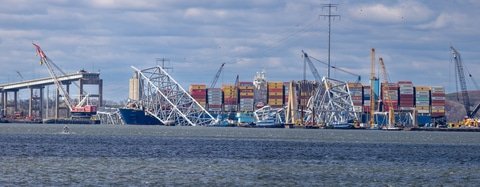Steady State Does Not Make for Resilient Supply Chains
“Dynamic optionality.” The words hit me like a runaway cargo ship striking a Baltimore bridge.
I’ve been championing optionality for supply chain for years. But while I’ve not been doing it wrong, my Tompkins Ventures Business Partner’s phrasing told me I haven’t been doing it exactly right.
Because in a world of perpetual disruption, businesses – and supply chains – must adapt quickly to survive.
That means even optionality, where I emphasize the importance of multiple sourcing, procurement and supply chain solutions to navigate disruptions, must evolve. Enter Dynamic Optionality for Manufacturing and Supply Chain (DOMS). This critical framework is key for thriving in a world where disruption is the new normal.
Fitting into the Reality of ReGlobalization – and Beyond
Optionality provides businesses with alternatives to respond when disruptions strike. Think about it: If a single source of raw materials dries up, optionality lets you pivot to another supplier. You can keep delivering while the competition falters. However, the static notion of optionality – relying on a fixed set of alternatives – is not sufficient.
Disruptions, whether geopolitical, environmental or economic, are no longer rare. They’re routine.
DOMS acknowledges that options themselves must evolve dynamically, as the viability of suppliers, partners and logistics networks constantly shifts. The only way to avoid “optionality-ing yourself into a corner” is by continuously reassessing and adjusting these alternatives.
DOMS, in many ways, equals how I view ReGlobalization – an innovation you will hear much more about in the coming weeks.
ReGlobalization marks a strategic shift from traditional globalization to more regionalized supply chains. Nearshoring, reshoring and friendshoring are central to this trend, helping businesses reduce dependency on distant regions like China. Yet, the disruptions never stop, forcing companies to reconfigure their strategies repeatedly.
So, once you’ve completed your ReGlobalization plans, you had best start on your ReReGlobalization plans. And then your ReReReGlobalization plans.
DOMS perfectly aligns with this concept. From now on, organizations must recalibrate their sourcing and manufacturing strategies proactively to face each new wave of disruption.
Putting Dynamic Optionality and ReGlobalization to the Test
Consider an apparel company navigating supply chain upheavals. A few years ago, they sourced most materials and finished goods from China. Like many companies, they leveraged the low costs and vast infrastructure of the “factory of the world.”
But tariffs, port and COVID shutdowns and geopolitical tensions left them scrambling. They started sourcing more finished apparel in Vietnam. Still, they knew much of the raw materials – buttons, fabrics and more – originated in China.
Still, the shift worked temporarily.
Now, they face potential tariffs of up to 60% on anything having anything to do with China. The company’s executive team is looking to Central and South America. Brazil is a potential source for menswear, sportswear, womenswear and workwear. Alternate sources include Colombia, Chile and El Salvador.
Simultaneously, the organization is establishing better partnerships in the Dominican Republic and Panama for logistics and transshipment.
This is DOMS – and ReReGlobalization – in action. And the executive team plans to continue monitoring the situation. Or ReReReGlobalization.
Because static optionality – locking in a fixed set of suppliers or solutions – leads to, well, stagnation. Sure, you can pat yourself on the back for diversifying sourcing. But one night you’ll get a phone call about an unexpected natural disaster or regulatory shift that compromises those sources. DOMS and ReReReGlobalization warn against complacency, emphasizing the need to perpetually re-evaluate your supply chain.
Building Your DOMS Strategy
To implement DOMS, organizations must:
- Leverage technology: Use advanced data analytics and AI-driven tools to gain real-time insights into supplier and logistics performance.
- Develop regional hubs: Build diversified regional supply chain networks to minimize the impact of disruptions.
- Foster strong partnerships: Cultivate relationships with suppliers and logistics providers who can adapt to shifting demands.
- Commit to continuous learning: Train leadership and supply chain teams to think dynamically, always planning the next move.
DOMS Equals Resilience
Dynamic optionality and ReReReGlobalization are more mindsets than strategies. They ensure your business can pivot faster and smarter than your competitors. By embracing DOMS and the principles of ReReReGlobalization, your organization can build a supply chain that thrives on change, delivering goods to customers no matter what obstacles arise.
The message is clear: if you’re not thinking dynamically, you’re not thinking strategically. Are you ready to embrace DOMS? The future of your supply chain depends on it.
Related Reading
- ReGlobalization- Redefining Global Supply Chains
- Supply Chain Knowledge Helps Power through Disruptions
- Free Trade Is Dead; Global Supply Chain Redesign Is Alive
- From Vision to Reality: Supply Chain Insights That Stand Up
Jim Tompkins, Chairman of Tompkins Ventures, is an international authority on designing and implementing end-to-end supply chains. Over five decades, he has designed countless industrial facilities and supply chain solutions, enhancing the growth of numerous companies. He previously built Tompkins International from a backyard startup into an international consulting and implementation firm. Jim earned his B.S., M.S. and Ph.D. in Industrial Engineering from Purdue University.

